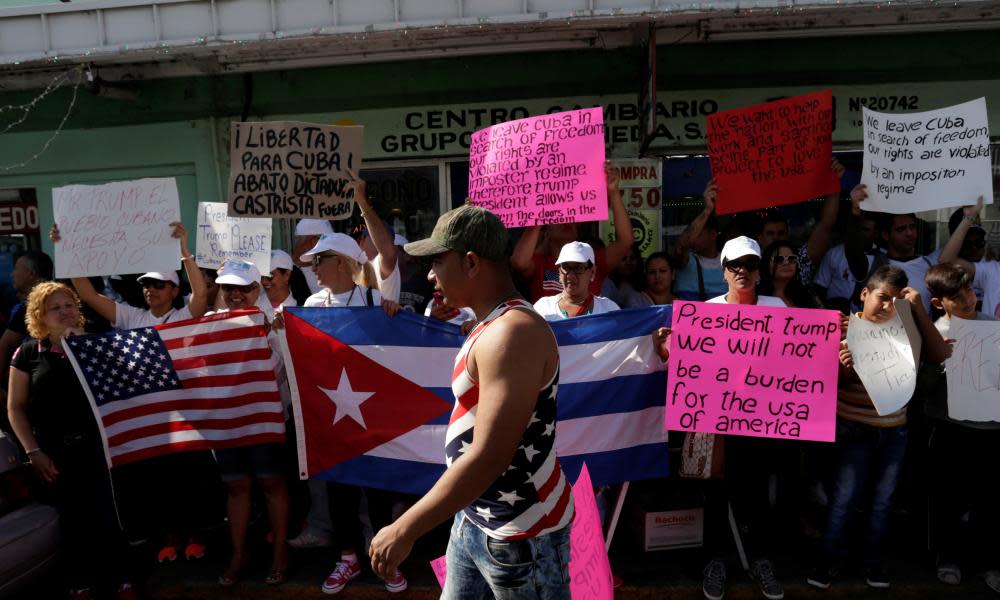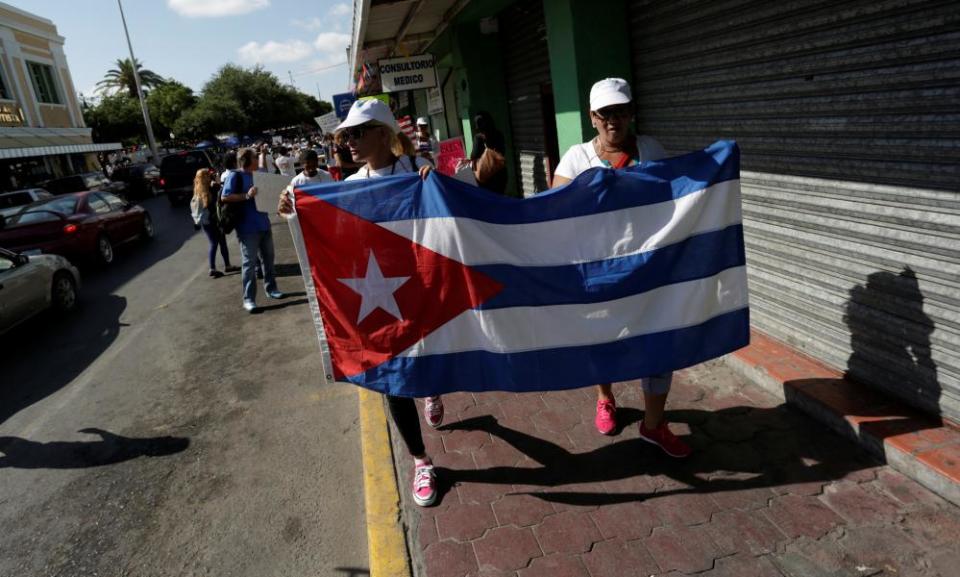'They threw us into the street': Cubans tell of struggles to enter US

Ana and Víctor arrived worn out and weary on an early morning bus and made their way straight for the bridge across the Rio Grande into Texas. The Cuban couple headed toward the US immigration offices, where they planned to apply for political asylum.
But American border officers blocked their way before they could plead their case.
“I told him: ‘Wait. We’re asking for political asylum, look at my passport.’ And he said they were not accepting Cubans,” said Ana, 49. “They threw us into the street.”
Ana and Víctor, who preferred not give their surnames, are among an estimated 1,000 Cubans who have arrived in Nuevo Laredo since 12 January, the day Barack Obama ended a policy of preferential treatment for Cuban migrants.
The “wet-foot, dry-foot” policy allowed any Cuban who reached US soil to become legal residents; its repeal as part of Obama’s detente with Havana effectively closed the border to Cuban migrants.
But Cubans have continued to converge at the border regardless, in the hope that Obama’s successor would return to a more hostile Cuba policy.
But when Donald Trump recently announced a partial rollback of Obama’s Cuba opening in June, he kept immigration restrictions intact.
“Why the hope with Trump? Because he is the only path we have to leave Cuba and reunite with family,” said Ana as she sat in a waiting room at a drug rehab clinic run by evangelical pastors, which has been turned into a makeshift shelter for Cuban migrants.
As for Obama, she said: “He only wanted to get along well with the king of Cuba.”
Obama’s sudden change in immigration policy caught Cubans off-guard, including those already en route.
Ana and Víctor, fierce critics of the Castros, had not started their trip in January. But they were determined to see through their plan to leave Cuba – and they felt they had no other option: several months earlier, the couple had sold their one-bedroom apartment in Old Havana to finance the journey.

Money from the sale paid for their daughter’s US visa application – which was eventually approved – and their own Mexican visas and plane tickets to Cancún, where they arrived in mid-May. For a few weeks, they washed cars and worked in restaurants to pay for their passage to Nuevo Laredo.
Others have taken more circuitous routes to the border, flying first to Ecuador – where the Cubans can still travel visa-free – then trekking through Colombia, Central America and the whole of Mexico.
When the policy changed, the Cubans congregated in public plazas near the border until local pastors started providing space in churches and rehab centres. Others now gather at a local Catholic-run shelter, which was already anticipating a surge in demand after Trump’s anti-migrant rhetoric and pledges to deport undocumented migrants.
“We were preparing for the Trump emergency when the Obama emergency arrived,” said Father Giovanni Bizzotto, a Scalabrini priest directing the Nazareth migrant shelter.
“There were a lot of people hoping and praying that Trump would change the Obama policy,” he said.
The municipality has provided the Cubans with three months of medical insurance, while immigration officials issued visas allowing them to reside and work in Mexico.
But approximately half the Cubans tired of waiting in Nuevo Laredo, walked across the border bridge and “surrendered” to US officials in the hope of claiming asylum. Others have requested asylum in Mexico, though most have not abandoned their hopes of entering the US.
Most of the migrants at the shelter are Central Americans fleeing gang violence and poverty, or Mexicans deported from the US and dumped in a city currently convulsed by organised crime violence.
The treatment of the Cubans, who can pass through Mexico with the proper papers, contrasts sharply with the thousands of Central Americans transiting the country as they flee poverty and violence back home.
Mexican immigration officials now detain and deport more Central Americans than their American counterparts, while migrants are often preyed upon by crooked cops and criminal gangs as they make their way north.
“It’s difficult to cross Mexico. With some luck you can cross it,” said Luis Oviedo, a Honduran who barely avoided a kidnapping attempt while travelling through the country and at one point walked for 10 days to avoid checkpoints.
Among the Cubans who remain at Bizzotto’s shelter, anger at Obama runs high.
“The US is a country of immigrants and they slammed the door in our face,” said Israel, 64, a heavy equipment operator.
Israel, who didn’t want to give his surname, spent seven years trying to reach Mexico. He worked along the way, including two years as a barman in Panama. He pulled out a tattered blue passport stamped and showed an Ecuadorian entry stamp dated 12 February 2010 – but still he seethed that the US border closed to Cubans before he could cross.
“I renounce the US,” he declared, raising his voice over the roar of a noisy ceiling fan. A little later, he admitted that he still hoped to cross the border one day to be reunited with a son living in New Orleans.

 Yahoo News
Yahoo News 
